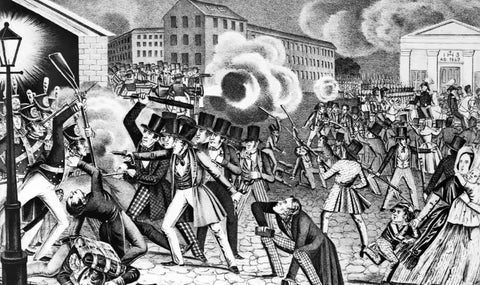Nativism Against the Irish in America: A Historical Perspective
Introduction
Nativism, the belief that native-born citizens are superior to immigrants, has manifested itself in various forms throughout American history. One significant episode of nativism unfolded in the 19th century, particularly against Irish immigrants. This essay delves into the roots, causes, and consequences of nativism against the Irish in America during this period.
Background: Irish Immigration to America

In the mid-19th century, a wave of Irish immigrants flooded into the United States, driven by the devastating effects of the Great Famine (1845-1852) and seeking economic opportunities. The Irish, predominantly Catholic, faced hostility as they entered a nation that was predominantly Protestant. This religious and cultural divide laid the foundation for nativism to take root.
Religious and Cultural Differences

One of the primary reasons behind nativism against the Irish was their religious affiliation. The majority of Americans at the time were Protestants, and they viewed the Catholicism of the Irish immigrants with suspicion and skepticism. The hierarchical structure of the Catholic Church, the allegiance to the Pope, and the traditions associated with Catholicism were perceived as conflicting with the Protestant values that shaped American society.
The Irish were also targeted due to their cultural differences. Their distinctive customs, language, and social practices set them apart from the predominantly Anglo-Saxon Protestant culture that dominated the United States. This cultural disparity fueled nativist sentiments, as many Americans feared that the Irish would undermine the established social order.
Economic Competition and the Labor Market
As the Irish immigrants arrived in the United States, they often faced harsh economic conditions. Many were forced to take low-wage jobs, particularly in industries such as construction and domestic service. This economic competition fueled resentment among native-born Americans, who saw the Irish as a threat to their livelihoods. Nativists argued that the influx of Irish labor was driving down wages and taking jobs away from American workers, contributing to the rising tensions.
Political Cartoon: "The Usual Irish Way of Doing Things"

A political cartoon titled "The Usual Irish Way of Doing Things" from the mid-19th century serves as a visual representation of nativist sentiments. The cartoon depicts Irish immigrants as drunken, violent, and prone to criminal behavior. Such stereotypes perpetuated negative perceptions of the Irish, reinforcing the nativist narrative that they were a menace to American society.
The Know-Nothing Party

The nativist movement gained political traction with the emergence of the Know-Nothing Party, officially known as the American Party, in the 1850s. The party, born out of secret societies like the Order of the Star-Spangled Banner, advocated for strict immigration controls and sought to limit the political influence of Catholics, particularly Irish Catholics.
The Know-Nothings targeted the Irish in their political platforms, arguing that the Irish posed a threat to American values and institutions. Their anti-immigrant stance gained popularity in certain regions, leading to the election of Know-Nothing candidates in local and state offices. This marked a pivotal moment in the institutionalization of nativism in American politics.
Violence and Discrimination

Nativist sentiments often escalated into violence against the Irish community. In cities such as New York and Boston, anti-Irish riots erupted, with nativist mobs attacking Irish neighborhoods and individuals. The violence was fueled by a toxic combination of economic anxiety, religious differences, and cultural clashes. Irish immigrants were not only subjected to physical assaults but also faced discrimination in employment, housing, and education.
Employment Discrimination
The Irish were often excluded from skilled professions and well-paying jobs, relegated to the lowest rungs of the economic ladder. Discrimination in the workplace was not only based on economic competition but also on a deep-seated prejudice against the Irish. Signs reading "No Irish Need Apply" were not uncommon in job postings, reflecting the extent of the discrimination faced by the Irish in their quest for employment.
Housing and Living Conditions

Irish immigrants were often confined to overcrowded and unsanitary living conditions in urban slums. These neighborhoods, characterized by dilapidated housing and inadequate sanitation, became hotbeds of disease and poverty. Discrimination extended to housing, as landlords and property owners often refused to rent to Irish tenants. This segregation exacerbated the challenges faced by the Irish community, perpetuating a cycle of poverty and marginalization.
Impact on Education
Irish children also faced discrimination in the education system. Nativist sentiments influenced the treatment of Irish students in schools, where they were often subjected to bullying and exclusion. The discrimination extended beyond the student body, as teachers, many of whom shared the nativist prejudices, contributed to a hostile learning environment for Irish children.
Legacy of Nativism: Irish-American Adaptation and Integration
Despite the formidable challenges posed by nativism, the Irish community in America persevered and gradually integrated into American society. Over time, as subsequent generations of Irish-Americans became more established, the stereotypes and discrimination lessened. The Irish-American experience became an integral part of the broader immigrant narrative, demonstrating resilience and the ability to overcome adversity.
Conclusion
Nativism against the Irish in America during the 19th century was a complex phenomenon driven by religious, cultural, and economic factors. The Irish, facing discrimination in various aspects of life, nonetheless managed to overcome these challenges and contribute significantly to the fabric of American society. Understanding this historical episode sheds light on the enduring themes of immigration, cultural diversity, and the ongoing struggle for acceptance in the United States. As the nation grapples with contemporary immigration issues, reflecting on the nativism against the Irish serves as a poignant reminder of the challenges faced by newcomers seeking a better life in America.